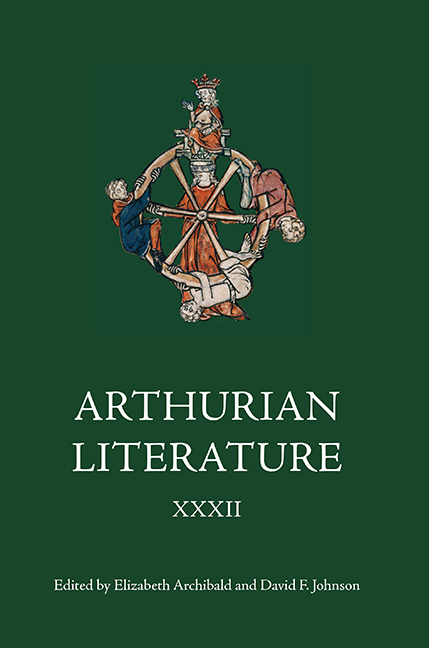Book contents
- Frontmatter
- Contents
- List of Illustrations
- General Editors’ Foreword
- List of Contributors
- I Wounded Bodies: Kingship, National Identity and Illegitimate Torture in the English Arthurian Tradition
- II The Place of Emotion: Space, Silence and Interiority in the Stanzaic Morte Arthur
- III Another Source for Malory’s ‘Tale of Sir Gareth’
- IV ‘Warre and Worshyppe’: Depictions of Battle in Malory’s Le Morte Darthur
- V Malory’s ‘Chivalric Cliques’: Public and Private Felyshyp in the Arthurian Community
- VI Scribal Modifications to Concluding Formulae in the Winchester Manuscript
- VII Heraldic Imagery in the Embroidered Tristan Narratives
- VIII Update to the List of Manuscripts of Geoffrey of Monmouth’s Historia Regum Britanniae
- Contents of Previous Volumes
I - Wounded Bodies: Kingship, National Identity and Illegitimate Torture in the English Arthurian Tradition
Published online by Cambridge University Press: 11 May 2021
- Frontmatter
- Contents
- List of Illustrations
- General Editors’ Foreword
- List of Contributors
- I Wounded Bodies: Kingship, National Identity and Illegitimate Torture in the English Arthurian Tradition
- II The Place of Emotion: Space, Silence and Interiority in the Stanzaic Morte Arthur
- III Another Source for Malory’s ‘Tale of Sir Gareth’
- IV ‘Warre and Worshyppe’: Depictions of Battle in Malory’s Le Morte Darthur
- V Malory’s ‘Chivalric Cliques’: Public and Private Felyshyp in the Arthurian Community
- VI Scribal Modifications to Concluding Formulae in the Winchester Manuscript
- VII Heraldic Imagery in the Embroidered Tristan Narratives
- VIII Update to the List of Manuscripts of Geoffrey of Monmouth’s Historia Regum Britanniae
- Contents of Previous Volumes
Summary
One of the most pervasive modern assumptions about the Middle Ages is that there was a proliferation of interrogatory torture carried out in secret, deep in dark dungeons stocked with cruel instruments. Barbara W. Tuchman and Johan Huizinga were instrumental in constructing a narrative of medieval brutality that persists in the modern imagination. The idea of torture and brutality being synonymous with the term ‘medieval’ is a prominent myth echoed in modern media and popular culture. But there is ample evidence that torture as medieval society understood it – the infliction of pain in a legal interrogation as means of extracting a confession, the ‘Queen of Proofs’ – was not a universal staple of medieval justice. Interrogatory torture was illegal in England (except in rare cases) until the early modern period and several other communities resisted its use. Yet the modern misconception holds, reinforced in some ways by the graphic depictions of torture in medieval hagiography; however, it is a relatively unusual occurrence in secular literature, especially Arthurian texts. Where it does occur, as in Cligés (5889–91, 5904–8, 5917–33) and the Roman van Walewein (7822–34, 7962–4), it is portrayed as a tool of the barbarian Other, employed only by those who do not live by either civilised or chivalric ethos. The English legal aversion to torture is reinforced by historical episodes of resistance; treatises decrying torture echo the sentiments of secular literature in which brief references to characters being ‘put to the question’ or ‘put to pain’ appear to denounce its application and question the justice of those who resort to it. Particularly in the fourteenth century, torture is an intertextual motif of poor governance. Several English Arthurian romances written during the tumultuous fourteenth and fifteenth centuries, the Hundred Years’ War, Richard II's fraught reign and the Wars of the Roses criticise the instability caused by weak kingship and betrayal that results in the use of torture, if only for a moment.
Martial violence is systematic in the majority of Arthuriana, but Arthur's court (with all its flaws) is a model of correct and legitimate justice that does not need to resort to torture to find truth.
- Type
- Chapter
- Information
- Arthurian Literature XXXII , pp. 1 - 30Publisher: Boydell & BrewerPrint publication year: 2015



